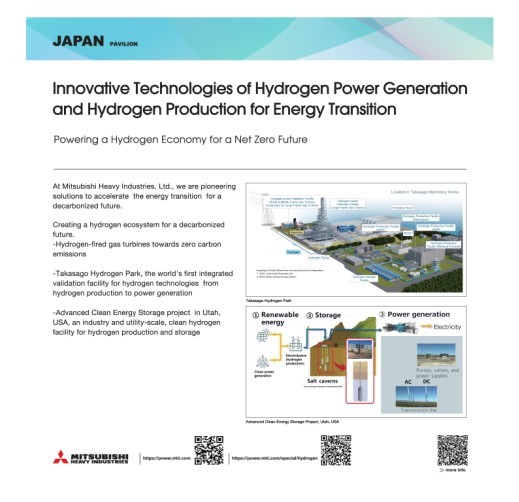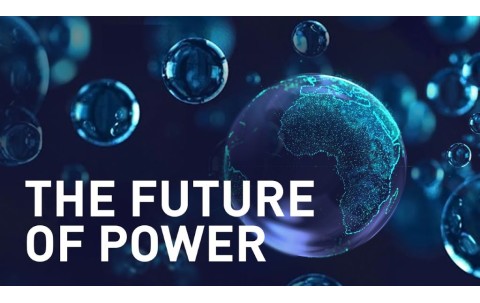Innovative Technologies of Hydrogen Power Generation and Hydrogen Production for Energy Transition
Technology / Service Summary
Against the backdrop of accelerating energy transition across the world, it is urgent need to achieve carbon neutrality in Gas Turbine Combined Cycle (GTCC) and steam power generation systems, which are the main products of Mitsubishi Heavy Industries, Ltd. (MHI). Decarbonization of these thermal power generation systems necessitates developing not only decarbonization technologies for power generation facilities but also hydrogen production technologies, which will be an alternative fuel.
Purpose
Solving global warming problems is critical to humanity. In October 2020, along with the growing momentum of international climate action such as the Conference of Parties (COP) on climate change, the Japanese government declared its intention of achieving “carbon neutrality” by reducing greenhouse gas emissions to net zero by 2050. The term “net zero” means that the total amount of greenhouse gases including carbon dioxide (CO2) becomes practically zero, when calculating the amount of “(artificial) emissions” minus the amount of “(artificial) absorption” through means such as afforestation and forest management. To achieve such carbon neutrality, it is indispensable to substantially expand the use of renewable energy. Simultaneously, it is also important to maintain economic efficiency and stable energy supply. MHI aims to achieve a carbon neutral society in a realistic and speedy way, while minimizing social costs by promoting energy transition of existing thermal energy facilities, e.g. power stations, chemical plants, and so on. Renewable energy greatly contributes to the achievement of a carbon neutral society. However, because weather is easy to change, the output from sources such as solar and wind is quite variable, making it difficult to respond to the demand that significantly changes every minute. The expansion of the use therefore requires the introduction of energy storage technology. In general, lithium batteries are advantageous for storing energy for a short period of time, but for a relatively long period of time, such as days or weeks, it is advantageous to convert it into chemical energy such as hydrogen, which can be stored and transported.
Feature
Having declared “MISSION NET ZERO”, MHI Group intends to achieve carbon neutrality Net Zero CO2 emissions from the group’s production activities and the entire value chain by 2040 concerning. MHI Group also aims to offer products and technologies that can make it viable for customers to achieve carbon neutrality by 2050. Our major undertakings include the energy transition for low-carbonization and decarbonization of businesses/products, and the expansion of carbon capture utilization and storage (CCUS) including CO2 capture and contribute to creating a carbon neutral society.
The introduction necessity of energy storage technologies and the strengths of each technology are as follows. Lithium batteries are advantageous for short-time storage, while conversion to chemical energy such as hydrogen is advantageous necessary for storing energy for a relatively long period of time such as days and weeks. It is expected that the use of renewable energy will become more common across many regions of the world and that hydrogen products produced through water electrolysis by using surplus renewable electricity will become widely used. On the other hand, in regions that are not rich in renewable resources such as Japan and South Korea, the application of ammonia with a high transportation efficiency will take precedence. There are also high expectations for turquoise hydrogen, which can be produced using existing natural gas infrastructure. Specifically, the production process is the pyrolysis of natural gas and is characterized by the by-product of solid carbon. As versatile as it may be, the term decarbonization can pertain to different technologies depending on the needs of each region, whose verification and social implementation are a matter of urgency.
Effect
Making use of the technologies for energy transition in this report, we aim to fulfil MHI Group’s declaration of “MISSION NET ZERO” for 2040 and thus also commit ourselves to contribute to the realize of a carbon-neutral society.
Controlled Substance
Applicable Regions / Countries
- Japan
- Southeast Asia
- Central/South Asia
- China/ East Asia
- Middle East
- Africa
- Oceania
- Europe
- Central/South America
- ASEAN countries
Indonesia,Cambodia,Singapore,Thailand,Philippines,Brunei Darussalam,Viet Nam,Malaysia,Myanmar,Lao PDR
Reference URL
Locations for inspection
Takasago Hydrogen Park, the World's First Integrated Validation Facility for Technologies from Hydrogen Production to Power Generation, Enters Full-Scale Operation. Electrolysis Hydrogen Production Begins.
・ Coordinated operation of production, storage and utilization equipment for hydrogen expected to lead to successive expansion of next-generation hydrogen production technologies
・ Accelerated commercialization of hydrogen gas turbines expected to contribute to the rapid realization of a carbon-neutral society
Related SDGs Goals
- 3. Good Health and Well-being
- 7. Affordable and Clean Energy
- 8. Decent Work and Economic Growth
- 9. Industry, Innovation and Infrastructure
- 11. Sustainable Cities and Communities
- 12. Responsible Consumption and Production
- 13. Climate Action
- 17. Partnerships to achieve the Goal

Youtube Videos






